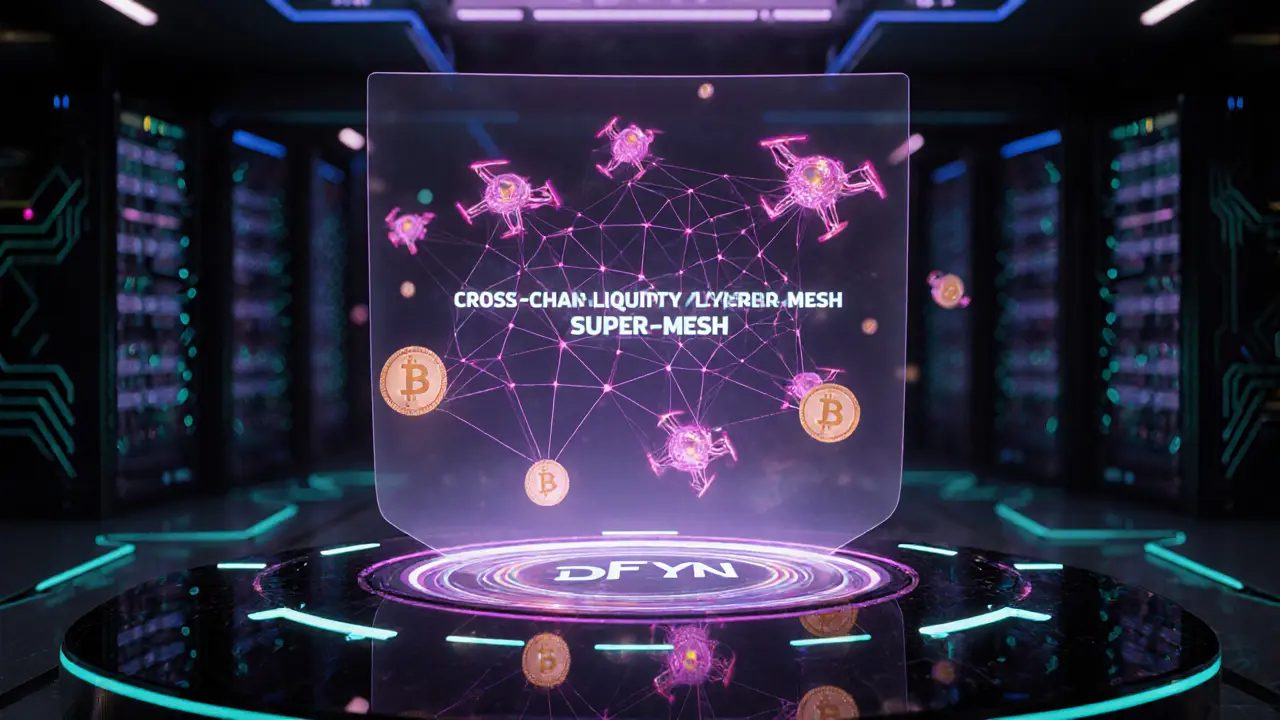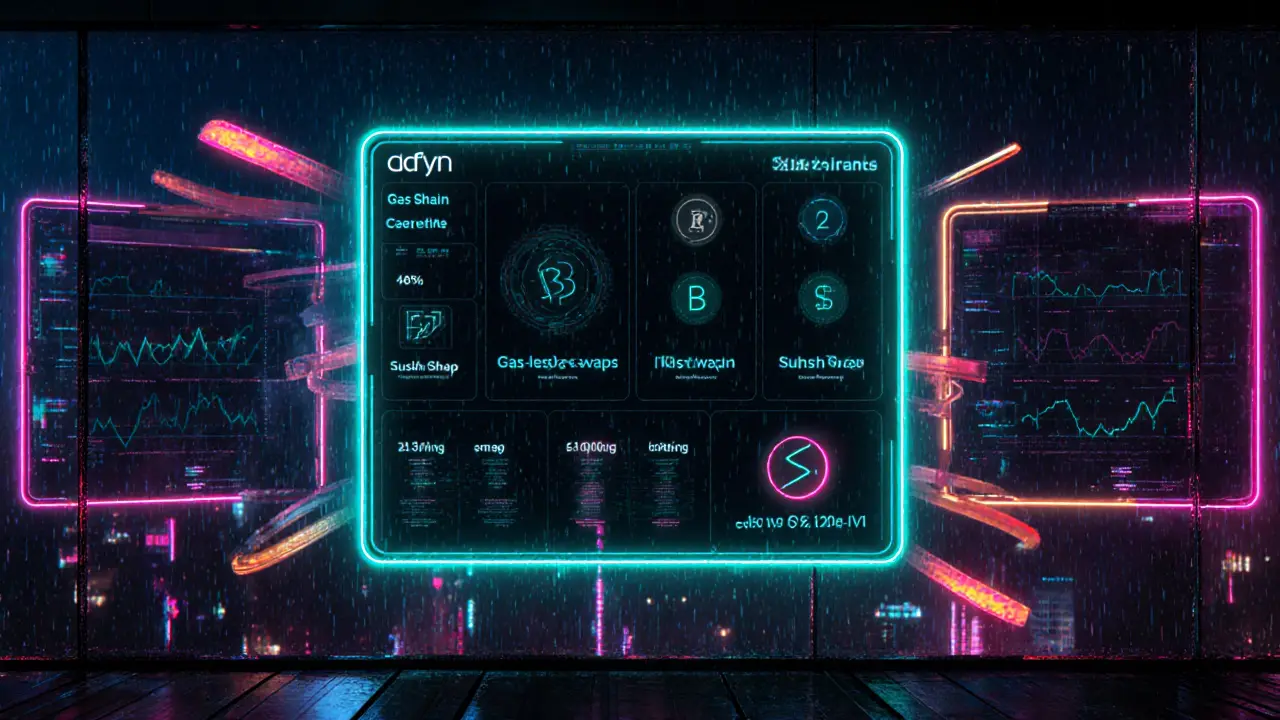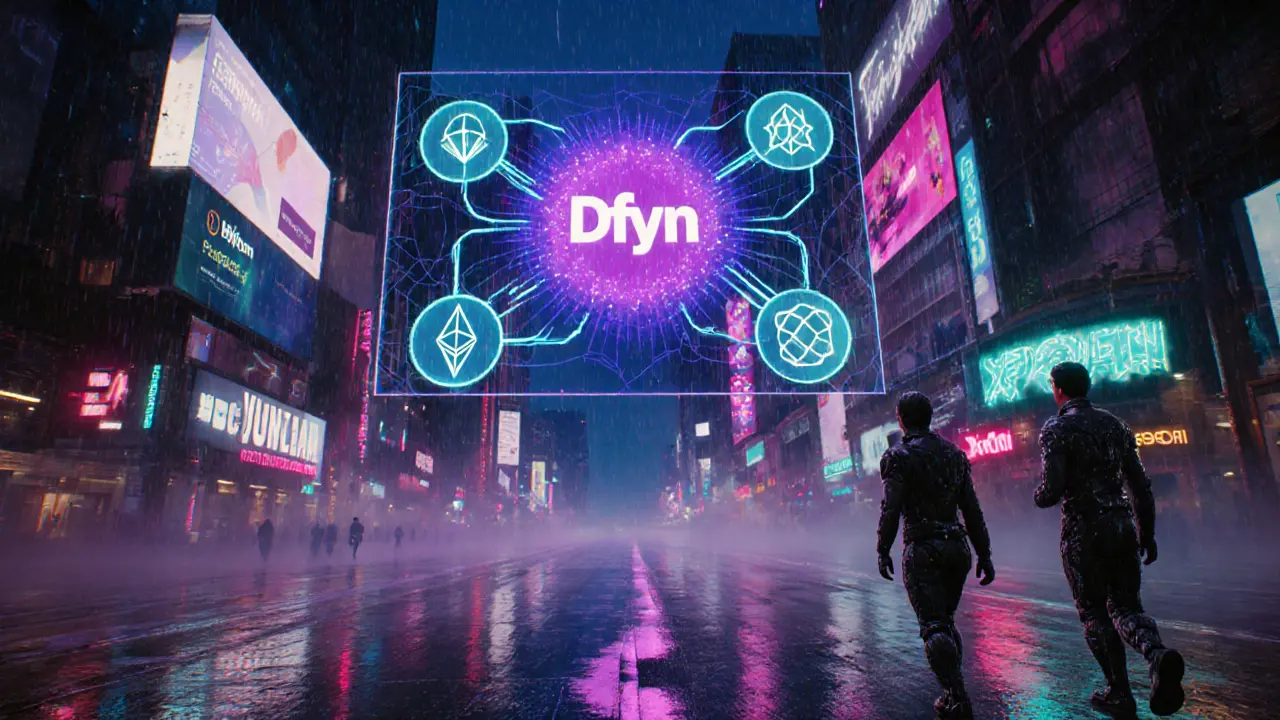Dfyn Network Feature Comparison Tool
Compare key features of Dfyn Network with popular decentralized exchanges:
| Feature | Dfyn Network | Uniswap | SushiSwap |
|---|---|---|---|
| Cross-chain swaps | Yes (Polygon, Ethereum, xDai, expand-able) | No (Ethereum-only, layer-2 via separate bridges) | No (Ethereum-only, layer-2 via separate bridges) |
| Gas-less transactions | Supported on Polygon and xDai | Not native, requires relayer services | Not native, requires relayer services |
| Native governance token | DFYN | UNI | SUSHI |
| Liquidity incentives | DFYN rewards + fee rebates | UNI rewards (limited) | SUSHI rewards + farms |
| Primary chain focus | Polygon + multi-chain | Ethereum + Optimism/Arbitrum (via forks) | Ethereum + multiple L2s (via forks) |
Supported Chains:
Polygon Ethereum xDaiAs of October 2025:
Token Price:
Market Cap:
Circulating Supply:
Token Use Cases:
- Governance Voting Power
- Fee Rebates Reduced Swap Fees
- Liquidity Incentives Staking Rewards
To begin trading on Dfyn:
- Install a Web3 wallet (e.g., MetaMask, Trust Wallet)
- Connect your wallet to the Dfyn web interface
- Select the chain you want to trade on (Polygon, Ethereum, or xDai)
- Choose a pool and confirm the swap
- Enjoy gas-less swaps on supported networks!
Key Benefits:
- Cross-chain access to multiple blockchains
- Low-cost, gas-less transactions on Polygon and xDai
- Decentralized control with no central custodian
- Incentive structure encourages deeper liquidity
Quick Overview
- Dfyn Network is a multi‑chain AMM DEX that runs on Polygon and other blockchains.
- DFYN token powers governance, fee rebates, and cross‑chain liquidity incentives.
- Gas‑less swaps and ultra‑fast confirmation are core user benefits.
- Non‑custodial design means you stay in full control of your assets.
- As of Oct2025 the token trades around $0.02 with most volume on the DFYN/USDT pair.
What Is Dfyn Network?
When you hear Dfyn Network is a multi‑chain decentralized exchange (DEX) protocol that uses an automated market maker (AMM) model to provide liquidity across several blockchain ecosystems. The project’s flagship goal is to make DeFi infrastructure cheap, fair, and accessible by letting traders move assets between chains without paying high gas fees.
How the Multi‑Chain AMM Works
At its core, Dfyn runs a set of AMM nodes that act as entry and exit points for liquidity on each supported chain. These nodes are glued together by the Router Protocol integration, which creates what the team calls a "cross‑chain liquidity super‑mesh".
The super‑mesh lets a trader on Polygon swap a token for an Ethereum‑based asset in a single transaction, while the underlying smart contracts handle the bridging behind the scenes. Because the routing happens at the protocol level, transaction times stay in the sub‑second range and most swaps are gas‑less for the end‑user.
Supported chains currently include Polygon (Layer‑2), Ethereum (Layer‑1), and xDai. The architecture is designed to add more networks without changing the user interface, which is why the platform promotes itself as truly blockchain‑agnostic.

DFYN Token Details
The native utility token, DFYN, serves three main purposes:
- Governance: Holders can vote on protocol upgrades, fee structures, and new chain integrations.
- Fee Rebates: Staking DFYN reduces the 0.3% swap fee to as low as 0.1% for active liquidity providers.
- Liquidity Incentives: Liquidity miners receive DFYN as a reward for supplying assets to the cross‑chain pools.
Supply‑side data is relatively scarce, but market snapshots from October2025 show a circulating supply of roughly 1.2billion DFYN tokens, a market cap near $2.4million, and daily trading volume dominated by the DFYN/USDT pair (over 96% of total volume).
Getting Started: Wallets, Connections, and Swaps
Dfyn is a non‑custodial platform, so you never hand over private keys. To start, you need a compatible wallet-MetaMask, Trust Wallet, or any Web3‑enabled mobile wallet will do. After installing the extension or app, simply click the "Connect Wallet" button on the Dfyn interface and approve the connection.
Once connected, you can:
- Provide liquidity to any pool across supported chains.
- Swap tokens instantly with gas‑less execution (the protocol subsidizes gas on supported layers).
- Stake DFYN to earn fee reductions and voting power.
The UI groups pools by chain, allowing you to filter for the best rates. Because the DEX is fully on‑chain, every trade is recorded on the relevant blockchain ledger, giving you full transparency.
Key Advantages and Potential Risks
Advantages
- Cross‑chain access: Trade assets on Ethereum, Polygon, and xDai without using separate bridges.
- Low cost: Gas‑less swaps keep fees minimal, especially for small‑scale traders.
- Decentralized control: No central custodian; you keep custody of your funds.
- Incentive structure: DFYN rewards encourage deeper liquidity and lower slippage.
Risks
- Liquidity depth can be thin on newer chains, leading to higher price impact.
- Cross‑chain bridges, even when abstracted, inherit the security risks of underlying bridge contracts.
- The token’s price volatility (hovering around $0.02) means staking rewards may not offset market swings.
- Limited public information on the founding team and roadmap can make long‑term confidence harder to gauge.
Feature Comparison with Other Popular DEXs
| Feature | Dfyn Network | Uniswap | SushiSwap |
|---|---|---|---|
| Cross‑chain swaps | Yes (Polygon, Ethereum, xDai, expand‑able) | No (Ethereum‑only, layer‑2 via separate bridges) | No (Ethereum‑only, layer‑2 via separate bridges) |
| Gas‑less transactions | Supported on Polygon and xDai | Not native, requires relayer services | Not native, requires relayer services |
| Native governance token | DFYN | UNI | SUSHI |
| Liquidity incentives | DFYN rewards + fee rebates | UNI rewards (limited) | SUSHI rewards + farms |
| Primary chain focus | Polygon + multi‑chain | Ethereum + Optimism/Arbitrum (via forks) | Ethereum + multiple L2s (via forks) |

Frequently Asked Questions
What blockchains does Dfyn Network support?
Currently Dfyn runs on Polygon (MATIC), Ethereum, and xDai. The protocol’s design allows additional layer‑1 and layer‑2 networks to be added without major UI changes.
How can I earn DFYN tokens?
You earn DFYN by providing liquidity to any of the cross‑chain pools and by staking the token in the Dfyn governance vault. Both actions generate periodic DFYN rewards based on pool size and your contribution.
Is Dfyn safe to use?
The platform is non‑custodial, meaning you always control your private keys. However, as with any DeFi protocol, smart‑contract bugs or bridge exploits can pose risks. Audit reports are publicly available on their GitHub, and users should start with small amounts.
Do I need to pay gas fees when swapping on Dfyn?
On supported layers like Polygon and xDai, Dfyn subsidizes the gas, making swaps effectively gas‑less for the end user. On Ethereum mainnet, normal gas fees apply because the network itself charges them.
How do I start trading on Dfyn?
Install a Web3 wallet (e.g., MetaMask), connect it to the Dfyn web interface, select the chain you want to trade on, choose a pool, and confirm the swap. The UI guides you through each step without requiring any personal information.






Comments
9 Comments
Santosh harnaval
Dfyn’s gas-less swaps on Polygon are a game-changer for small traders. No more worrying about $50 gas fees just to swap 10 bucks worth of tokens.
Claymore girl Claymoreanime
Honestly, this is just another rebranded AMM with a fancy name and a token that’s barely worth the electricity it takes to display it. If you’re staking DFYN at $0.02, you’re not investing-you’re donating to a speculative experiment. Real DeFi has a market cap above $100M, not $2.4M.
Will Atkinson
I’ve been using Dfyn for a few months now, and honestly? It’s quietly brilliant. The way it handles cross-chain swaps without making you juggle five different bridges is a revelation. I used to hate swapping between Polygon and Ethereum-now it’s just a click. And the fee rebates? Totally worth staking a little DFYN. It’s not flashy, but it just… works. Like a well-oiled machine you didn’t know you needed.
monica thomas
The documentation provided is thorough and the architecture appears to be well-conceived. However, I must emphasize the importance of verifying the audit reports from reputable third-party firms prior to engaging with any smart contract infrastructure. The absence of a publicly disclosed founding team remains a concern from a governance transparency standpoint.
Edwin Davis
This is why America needs to stop letting foreign devs build our financial infrastructure. Polygon? xDai? These are just Chinese-backed sidechains pretending to be decentralized. Real DeFi runs on Ethereum, and if you’re not using Uniswap, you’re gambling with your money.
emma bullivant
I think Dfyn is kinda cool but i think the tokenomics are a little off? like if the supply is 1.2billion and price is 0.02 then why does it feel like no one is using it? maybe im just dumb but i think the rewards arent enough to offset the risk of bridge exploits
Michael Hagerman
I don’t know why everyone is acting like this is some revolutionary breakthrough. It’s just a DEX with a slightly better UI. The fact that you’re calling it a ‘cross-chain liquidity super-mesh’ makes me want to roll my eyes. Also, the team’s GitHub hasn’t been updated since March. That’s not innovation-that’s abandonment.
Laura Herrelop
Have you ever wondered why Dfyn is so focused on Polygon and xDai? Those chains are controlled by centralized entities with ties to major financial institutions. This isn’t DeFi-it’s a front for institutional asset laundering. The gas-less swaps? They’re tracking your transactions. The DFYN token? A honeypot. They’re collecting your wallet data and selling it to the highest bidder. Don’t be fooled by the ‘non-custodial’ label. If you can’t see the strings, you’re already puppet.
Nisha Sharmal
India has better DeFi projects than this. Why are we even talking about a project that doesn’t even have a proper whitepaper? At least our own SwapFi has real team members with LinkedIn profiles. This looks like a VC pump-and-dump with a pretty table.
Write a comment